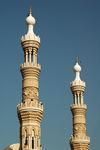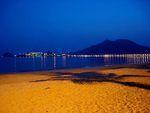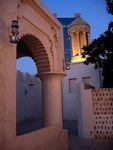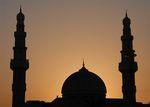Sharjah

Sharjah is the third largest of the seven emirates that make up the United Arab Emirates and occupies a unique position straddling the Arabian Peninsula, with the Arabian Gulf to its west and the Gulf of Oman to its east. This affords Sharjah a diverse geography, with some spectacular scenery. Known as the cultural capital of the United Arab Emirates, and also the UNESCO Cultural Capital of the Arab World in 1998, Sharjah boasts perhaps more than its fair share of cultural attractions.
----------------------------------------------------------------------------------------------------------------------------------------------------------
Fast Facts

Capital City – Sharjah Population Size: Country Size: 2600sq kms Currency/FX rate: Emirati Dirham (current rate £1 = 7.37 dirham) Time Zone: +4GMT Language: Official language is Arabic, though English is widely used. Hindu and Urdu are also common languages Weather: Sharjah's climate is idyllic from November to April with warm sunny days, cool evenings and low humidity. It is hot from May to September, with temperatures in July reaching more than 45 degrees C. Rainfall and tropical storms are to be expected during January – March. Daytime temperatures range from 18 to 30 degrees C. Visa: British travellers to Dubai do not need a visa.
----------------------------------------------------------------------------------------------------------------------------------------------------------
History and Culture

There is evidence to support the belief that Sharjah has been inhabited for around 6000 years, and numerous archaeological discoveries have been found. The East Coast of Sharjah has been ruled over by Portugal, the Netherlands and Britain, all keen to establish control over the spice trade in the region, until the formation of the Trucial States in 1853.
The United Arab Emirates were founded in 1971. In the 1930s the British built an airport, the first in the Emirates, in Sharjah, to act as a stopover point en route to India. The runway still exists today as a main road.
Oil and gas were found in the 1970s, and Sharjah has not looked back since. These natural resources have ensured Sharjah’s wealth and development as one of the premier destinations in the Middle East.
Sharjah is well known throughout the Arab world for its cultural associations and pride in its traditions, and there are numerous museums, art galleries and heritage areas to visit.
----------------------------------------------------------------------------------------------------------------------------------------------------------
Things to do

Sharjah boasts a number of beaches, all with warm waters and popular with watersports enthusiasts, swimmers and sun worshippers. Al Khan Lagoon, between Sharjah and Dubai, is popular with waterskiers and jet skiers. The beach at the Oceanic Hotel is the only town beach, but further along the coast are numerous sandy beaches.
Fishing: Other than in the summer months, all along the coast of Sharjah as well as further out to sea it is possible to fish in the waters of the Arabian Gulf and the Gulf of Oman for king fish, tuna, barracuda, red snapper, and hamour.
Sand-skiing: What is fast becoming a favourite pastime in the Middle East, sand skiing is possible on a steep sand dune half way from Sharjah to Hatta.
Dune Buggies: Also in the vicinity, on Fridays you can hire dune buggies and go for an adventure over the dunes. Most tour operators offer this as an excursion.
Mountain Biking: For those looking for some exercise and adventure, mountain biking in Sharjah is a great way to spend the day. Sharjah offers some terrain more suited to the less experienced cyclist than elsewhere in the UAE, and some popular flatter routes are to be found along the coast from Ajman towards Ras al Khaimah, through Sharjah. There are some tougher routes through the Wadid Thaveba between Masafi and Dibba.
Diving and Watersports: The waters off the Al Khan beach, the lagoons between Sharjah and Dubai, Hamriya and Umm Al Quwain creeks are perhaps the best locations for jet skiing and water skiing as the waters are calm and sheltered.
Windsurfing is mainly around the Al Khan lagoon and the Corniche Beach.
Numerous dive centres can be found throughout Sharjah, and there are popular dive sites on both coasts. There is more wreck diving on the Arabian Gulf and natural dive sites on the East Coast. Diving is possible year round, and the waters are warm and relatively unpolluted. Off the East Coast, in the warm waters of the Indian Ocean, you may spot turtles and sharks amongst the coral reef. Favourite dive sites include Dibba Rock, Lima, and Shark Island.
Parks: The Sheikh of Sharjah has decreed that a large share of Sharjah’s municipal budget be spent on the creation of parklands. There are a number of large parks throughout Sharjah, notable amongst them being the National Park, the largest at 630,000 sqm, which even has a dry ski slope.
Shopping: Sharjah ranks third behind Dubai and Doha with regard to shopping centre square footage per head of the population, overtaking Abu Dhabi. Shopping Malls include the Sharjah Mega Mall, and the Sahara Centre.
----------------------------------------------------------------------------------------------------------------------------------------------------------
Accommodation and Eating Out

Although less well known than Dubai and Abu Dhabi, Sharjah is an established tourist destination with around 250,000 visitors a year, so a wide range of accommodation options from luxury hotels to furnished apartments is available. In Sharjah City, most of the hotels are located along Al Khan beach. As well as a variety of hotels, Sharjah also boasts an increasing number of restaurants serving a variety of global cuisines to suit all budgets.
----------------------------------------------------------------------------------------------------------------------------------------------------------
Getting there and Around

As with the other Emirates, driving is the easiest way to get around. Driving is on the right hand side of the road. It is best to avoid the rush-hour between Dubai and Sharjah in the mornings and evenings. Drivers should be aware of camels on the roads, especially at night.
|